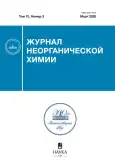Features of reactions of α-substituted acetylacetonate complexes
- Authors: Svistunova I.V.1, Tretyakova G.O.1
-
Affiliations:
- Far Eastern Federal University, Institute of Science-Intensive Technologies
- Issue: Vol 70, No 3 (2025)
- Pages: 394-401
- Section: КООРДИНАЦИОННЫЕ СОЕДИНЕНИЯ
- URL: https://rjsvd.com/0044-457X/article/view/684988
- DOI: https://doi.org/10.31857/S0044457X25030119
- EDN: https://elibrary.ru/BAVHVY
- ID: 684988
Cite item
Abstract
The reactions of coordinated ligands in acetylacetonate complexes of chromium and boron difluoride were studied by chromatograph mass spectrometry. It was found that bromo- and thiophenyl-substituted acetylacetonates of boron difluoride, unlike chromium complexes, do not interact with thiophenol. The interaction of thio-substituted chelates with SO2Cl2 also occurs differently. For chromium complexes, the reaction is accompanied by the replacement of the thioalkyl or thioaryl substituent by a chlorine atom. Thioethyl-substituted acetylacetonate of boron difluoride reacts with SO2Cl2 like aromatic analogues with chlorination of the ethyl group. Thioaryl-substituted acetylacetonate of boron difluoride does not react with SO2Cl2. In addition, it was found that bromo- and thiosubstituted chromium acetylacetonates react with sulfenyl chlorides with the replacement of the α-substituent by a chlorine atom. It was suggested that the difference in the reactivity of chromium acetylacetonates and boron difluoride is due to different charge distributions in the chelate cycle. The significant electroacceptor character of the BF2 group leads to the appearance of a positive charge on the substituent associated with the chelate cycle of the boron complexes.
Full Text
About the authors
I. V. Svistunova
Far Eastern Federal University, Institute of Science-Intensive Technologies
Author for correspondence.
Email: svistunova.iv@dvfu.ru
Russian Federation, Vladivostok
G. O. Tretyakova
Far Eastern Federal University, Institute of Science-Intensive Technologies
Email: svistunova.iv@dvfu.ru
Russian Federation, Vladivostok
References
- Marciniec B., Pietraszuk C., Pawluć P., Maciejewski H. // Chem. Rev. 2022. V. 122. № 3. P. 3996. https:// doi.org/10.1021/acs.chemrev.1c00417
- Пушкарев А.П., Бочкарев М.Н. // Успехи химии. 2016. Т. 85. С. 1338.
- Сыркин В.Г. CVD-метод. Химическое парофазное осаждение. М.: Наука, 2000. 496 с.
- Туранова О.А., Гарифзянова Г.Г., Туранов А.Н. // Журн. общ. химии. 2010. Т. 80. № 11. С. 1854.
- Мирочник А.Г., Федоренко Е.В. // Изв. АН. Сер. хим. 2023. Т. 72. № 1. С. 223.
- Мирочник А.Г., Любых Н.А., Федоренко Е.В., Белолипцев А.Ю. // Изв. АН. Сер. хим. 2023. Т. 72. № 5. С. 1122.
- Collman J.P. // Angew. Chem. Int. Ed. 1965. V. 4. № 2. P. 132. https://doi.org/10.1002/anie.196501321
- Collman J.P., Marshall R.L., Young W.L. et al. // Inorg. Chem. 1962. V. 1. № 3. P. 704.
- Гухман Е.В., Реутов В.А. // Журн. общ. химии. 2003. Т. 73. № 10. С. 1671.
- Yoshida Z., Ogoshi H., Shimidzu Y. // Tetrahedron Lett. 1969. V. 10. № 27. P. 2255. https://doi.org/10.1016/S0040-4039(01)88134-X
- Yoshida Z., Ogoshi H., Shmidzu Y. // Kogyo Kagaku Zasshi. 1969. V. 72. № 8. P. 1648.
- Реутов В.А., Свистунов Г.М., Шапкин Н.П. // Журн. общ. химии. 1987. Т. 57. № 9. С. 2060.
- Свистунова И.В., Шапкин Н.П. // Журн. общ. химии. 2013. Т. 83. № 11. С. 1859.
- Свистунова И.В., Шапкин Н.П., Свистунов Г.М. // Журн. общ. химии. 2001. Т. 71. № 9. С. 1435.
- Свистунова И.В., Федоренко Е.В. // Журн. общ. химии. 2008. Т. 78. № 8. С. 1280.
- Singh P.R., Sahai R. // Austral. J. Chem. 1967. V. 20. № 4. P. 639. https://doi.org/10.1071/CH9670639
- Weissberger A., Proskauer E.S., Riddick J.A., Toops E.E. Organic Solvents. Physical Properties and Methods of Purifiation. N.Y.: Interscience Publ., 1955. 552 p. https://doi.org/10.4236/msa.2015.61001
- Гетероциклические соединения. Т. 5. Пер. с англ. / Под ред. Элдерфилда Р. М.: Изд-во иностр. литер., 1961. 602 с.
- Свистунова И.В., Герасименко А.В., Короченцев В.В. и др. // Журн. структур. химии. 2012. Т. 53. № 6. С. 1129.
- Коваль И.В. // Успехи химии. 1995. Т. 64. № 8. С. 781.
- Свистунова И.В., Шапкин Н.П., Зязева М.Ю. // Журн. общ. химии. 2010. Т. 80. № 12. С. 1968.
- Mitchell R.H. // Tetrahedron Lett. 1973. V. 14. № 44. P. 4395. https://doi.org/10.1016/S0040-4039(01)87231-2
- Thea S., Cevascko G. // Tetrahedron Lett. 1988. V. 29. № 23. P. 2865. https://doi.org/10.1016/0040-4039(88)85232-8
- Kharasch N., Langford R.B. // J. Org. Chem. 1963. V. 28. № 7. P. 1903. https://doi.org/10.1021/jo01042a507
- Свистунов Г.М., Шапкин Н.П., Разов В.И. и др. // Журн. общ. химии. 1990. Т. 60. № 6. С. 1359.
Supplementary files
















